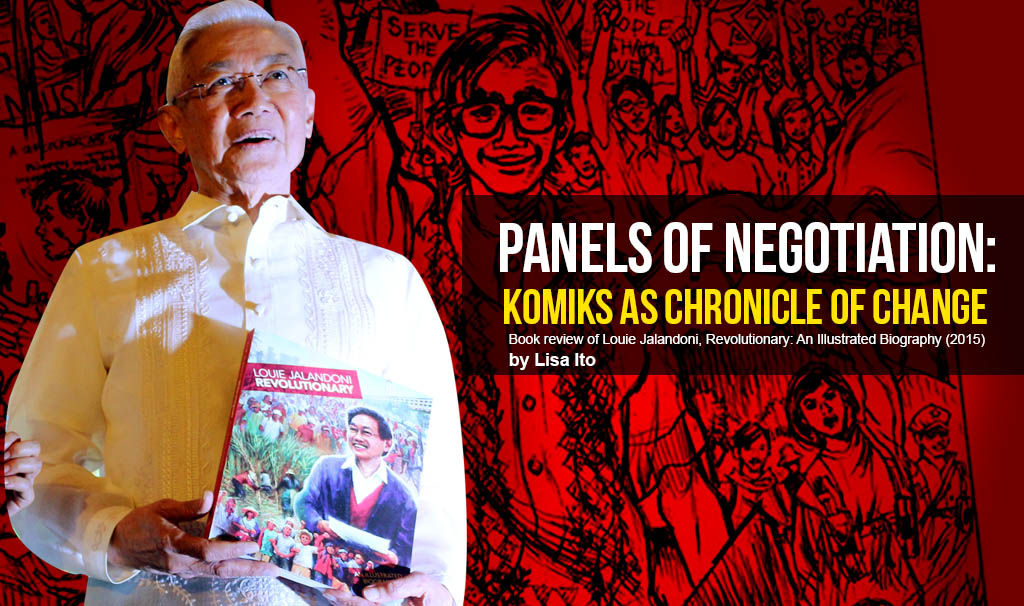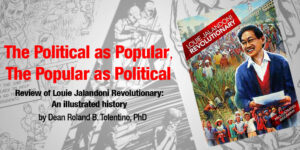I first heard of the name Luis Jalandoni as a young campus journalist, assigned to cover a university forum on the peace negotiations between the GRP and the National Democratic Front. Back then, I remember being slightly amazed upon learning that the chairman of the NDFP’s negotiating panel was a priest turned revolutionary, and have curiously wondered how and why this came to be.
The book Louie Jalandoni, Revolutionary: An Illustrated Biography surfaces the extraordinary story behind this transformation. What makes it doubly special is how it mainly employs komiks to do so—the local use of which can be traced to the late 1920s in the history of Philippine art. But unlike komiks in the tradition of Kenkoy, which are loved for their entertaining and humorous bent, the ones in the book are more historical and narrative in nature: committed to portraying a revolutionary’s life through realism.
The book is stunning on its own, as a visual art project. But it also harks back to a longer tradition of cultural resistance using popular art forms. Over the past four decades, the national democratic movement has used comics, cartoons and illustration for propaganda and educational materials, to convey political messages to different publics. Art historian Alice Guillermo, for instance, has written about how organisations such as the NPAA ’71 and the social realists produced comics versions of Amado Guerrero’s Lipunan at Rebolusyong Pilipino as well as materials for sectoral campaigns. Underground publications, such as Ulos, also made use of these. All tried to infuse revolutionary content and purpose into popular forms.

Like many of these past projects of the movement, the book Louie Jalandoni, Revolutionary uses and at the same time departs from tropes found in traditional komiks. Yes, it recounts adventures; though these are staged not in mythical far-away lands but in the countrysides and cities of the Philippines, where semi-feudal exploitation and fascist rule are everyday realities. Yes, it describes daring exploits and deeds: but these are achieved not through the wielding of supernatural or superhuman powers, but through a resolve to stand by what is just. Yes, it even offers its share of romance with a love story: one arising not from a predestined, inevitable meeting of hearts, but one forged during the shared struggle for the people.
The book is commendable for the accounts, testimonies and memories gathered into a single narrative by its author, Ina Alleco Silverio. Credit should also be given to the artists who made visible the facets and transitional phases of Ka Louie’s life. They represent different generations of progressive artists based inside and outside of the Philippines, each with distinct styles and artistic strategies that complemented the texts.
[masterslider id=”9″]
[real3dflipbook id=”1″]
Click above to flip through the sample pages
Utilizing new media such as digital painting, Bobert Elyas combines digital technology and photographic archives to convey both the nostalgia and grit of Ka Louie’s childhood, marked by affluence and the experience of war. Max Santiago also combines illustration with digital elements to depict Jalandoni’s journey into the simple life of priesthood: weaving through slums and rural communities, finishing his itinerant studies and settling back in Negros.
Enrico Maniago’s delicate and wiry style portrays in great detail the unease and ferment of feudal Negros, conveying not only a sense of place but also the encounters with exploitation that occur within these spaces. Renan Ortiz’s strong figures mirrors the resoluteness of Ka Louie’s transition and recruitment into the revolutionary cause. Leonilo Doloricon’s disciplined linear aesthetic and strong sense of composition complements the narratives of Jalandoni’s life in the underground and his participation in the resistance against Martial Law.
These changing portraits of Jalandoni in the book reveal his process of transformation: from a child within a society in transition to a steadfast priest, dedicated to service; from a respected supporter of the underground movement to, indeed, a statesman, of the revolutionary government that the NDF also embodies.
Other turning points in Ka Louie’s biography are also effectively captured by Fernando Argosino, who uses dramatic contrasts between light and dark to portray life in prison, and Mervin Malonzo, whose expressionistic style of illustration gave a psychological intensity to vignettes and portraits of Jalandoni during his escape and exile.
Last but not least are the contributions of Jaco Payawal to the layout of the book and the portrait of Jalandoni by Rafael Maniago for the cover, which captures the revolutionary optimism that has sustained him and many others until today.

The power of the image lies in how it can capture not only visible reality, but also, somehow, unseen shifts in consciousness. These changing portraits of Jalandoni in the book reveal his process of transformation: from a child within a society in transition to a steadfast priest, dedicated to service; from a respected supporter of the underground movement to, indeed, a statesman, of the revolutionary government that the NDF also embodies.
Altogether, these panels of composite images and texts work to build a portrait of a comrade who not only lived through the most interesting of times, but who also served as a steadfast pillar for radical social change.
I view the biography as a still unfinished project, for Ka Louie and Ka Coni are here with us today: ready to continue this narrative through their presence and practice alongside many others in the struggle for national liberation and democracy.
As individuals within a movement, I think each revolutionary has their own special story of transformation. Ka Louie and Ka Coni, thank you for sharing yours. It is humbling to think of how your extraordinary journey from Negros to the Netherlands belongs to a larger narrative of change: part of the ever shifting expanse and advance of the Philippine revolution.
Louie Jalandoni: Revolutionary is available at Popular Bookstore and IBON Bookstore. Visit Popular Bookstore at #305 FLP Building, Tomas Morato Avenue, Quezon City. IBON Bookshop is located at 114 Tomas Morato Avenue, Quezon City.
Click below to read Dean Roland B. Tolentino’s review of the book































